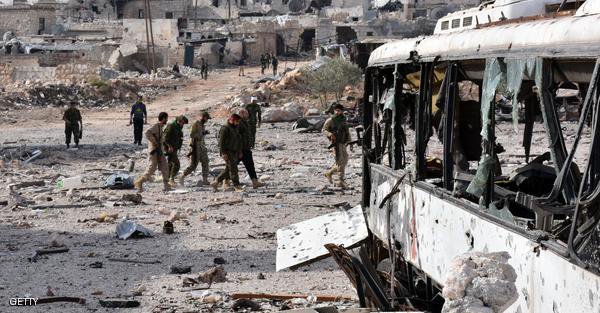For the past several days, Damascus has been advertising a major — and what it believes will be final — assault against the myriad rebel groups holding the eastern side of Aleppo, Syria's largest city.
On Sunday, residents and rebels there received text messages from the Syrian government, warning them to leave or face a major military onslaught.
There are an estimated 250,000 people in the rebel-held areas hemmed in by the Syrian army.
"To the armed people in the neighbourhoods of east Aleppo, we are giving you 24 hours only to decide if you are leaving," it read, according to news agencies.
"Your leadership abroad is incapable of getting you out. Whoever wants to stay alive must drop his weapons and we will secure his safety. After the 24 hours is up, we will implement a strategic attack using highly sophisticated weapons."
Arduous journey to Aleppo
Syria is one big grid of deadly rivalry. And control of Aleppo is considered the biggest prize of all. To get there from the capital, Damascus, you have to navigate at least 30 checkpoints over a seven-hour drive. And that's when you're travelling through government-held territory.CBC correspondent Margaret Evans is shown near Aleppo. The battle for the besieged city changed dramatically in 2015, when Moscow intervened on behalf of the Syrian government. (Stephanie Jenzer/CBC)
The government-run checkpoints are short, sharp points of frenetic activity, breaking up long stretches of road through dry desert.
The journey is made much longer by the need to detour away from stretches of land held by the latest incarnation of the jihadist al-Nusra Front or the militants of the Islamic State.
On the road to Aleppo, there were clear signs of the promised military assault lumbering to life. (Margaret Evans/CBC)
At one checkpoint, we saw someone hauled off a bus. At another, the military police arrived to interrogate a young man apparently trying to evade military service.
And today on the road, there were clear signs of the promised military assault lumbering to life.
In Homs, another city brought to its knees by the conflict, a Russian ammunition convoy rumbled through on the road to Aleppo, accompanied by a tank with five Russian soldiers perched on top of it.
Russia tips balance in Assad's favour
The battle for Aleppo changed dramatically in 2015 when Moscow intervened on behalf of the Syrian government, shifting the balance of power in favour of Syrian President Bashar al-Assad.Russia has a permanent military installation near the port city of Tartus along the Syrian coast. A full battle group of Russian warships arrived in the Mediterranean over the weekend, heightening speculation that a major land and sea assault is about to begin.
Syrian troop reinforcements are also on the move, some seen saying goodbye to their families before boarding buses just north of Homs.
Posters of Bashar al-Assad line the roads and plaster the walls of the checkpoints, peeking out from behind chipped blast-walls adorned with painted images of the Syrian flag in fading colours. (Margaret Evans/CBC)
The road to Aleppo is also paved with the portraiture of the conflict. Posters of Assad line the roads and plaster the walls of the checkpoints, peeking out from behind chipped blast-walls adorned with painted images of the Syrian flag in fading colours.
At one roadside café not far from the Lebanese border, workers were just putting the finishing touches on a rooftop billboard featuring Assad alongside Hassan Nasrallah, leader of the Lebanese paramilitary group and political party Hezbollah. They were using a hairdryer to try to make the edges stick.
Constant spectre of death, conflict
The closer you get to Aleppo, the more likely you are to see Shia militias from Iran and Iraq manning the checkpoints in government-held territory.Cars approaching the grey husks of destroyed and mostly abandoned buildings on the outskirts of Aleppo start to race the setting sun, so as not to get caught in the wrong part of town at night.
The road is lined with makeshift sniper screens. Old oil barrels, blast walls and tin sheets are strung together in a line to block vehicles from sight over the final few kilometres before West Aleppo comes into sight.
In Aleppo, there is the heavy thud of mortars hitting their targets and the deadly crack of machine gun fire, a constant reminder of the daily loss of life in this city. (Stephanie Jenzer/CBC)
But all the while, in the background, there is the heavy thud of mortars hitting their targets and the deadly crack of machine gun fire just a few neighbourhoods away, a constant reminder of the daily loss of life in this city.
Now, the United Nations is warning that the people in Aleppo's eastern neighbourhoods are in danger of starvation. Many have been besieged for months without essential supplies.
The road to Aleppo is paved with many things. But not one of them is peace.
------------









 Home
Home Politics
Politics











